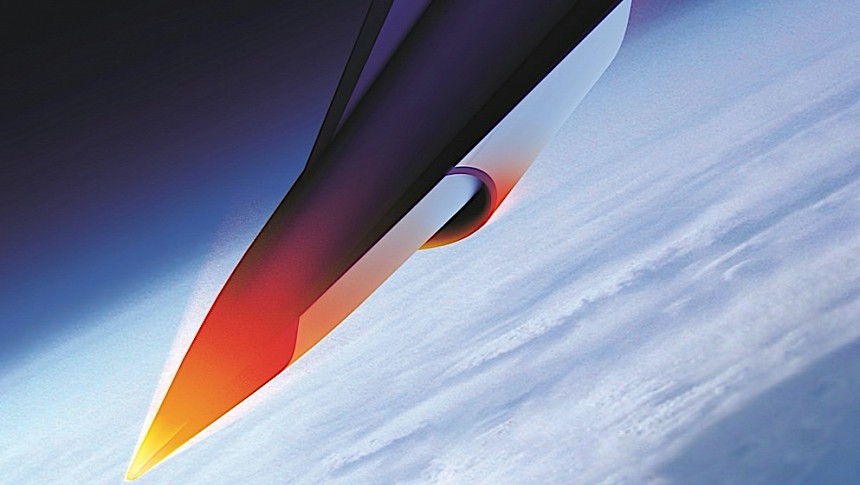The world of hypersonics is perhaps just as captivating to some people as say space exploration is to others. After all, it's all about going really, really fast through Earth's atmosphere, many times using technologies we barely knew existed a few years back.
The world's militaries are the ones most interested in research going on in this field, because they are among the first to actively use such devices for their own destructive purposes. But applications of hypersonic technologies of course go beyond that, and may one day impact research and development of more benign applications.
There are several ways of achieving hypersonic speeds, and a new one was just added to the list by GE Aerospace. It's called hypersonic dual-mode ramjet (DMRJ) with rotating detonation combustion, and according to its maker it's supposed to be a world's first.
As you know, a ramjet is an air-breathing engine that has no major moving parts. It uses the movement of the aircraft it powers to draw in air, compresses it, and then helps with the ignition of fuel in self-sustaining combustion.
Such engines are already in use elsewhere, but generally speaking they are used in conjunction with traditional combustion. The rotating detonation combustion (DRC), however, is believed to be a more efficient way of doing things, as it uses closely coupled shock waves to push the aircraft forward.
GE Aerospace tested exactly such a configuration on a rig located at its research center in Niskayuna, New York. It called the test a success, but does not say exactly what that means. We will get, however, as soon as 2024, more details on that, as the company plans a scale test of the technology.
Technically speaking a standard DMRJ can only be effective above Mach 3, because that's when it can be used. The addition of rotating detonation combustion could have ramjet engines spring into action sooner than that. In turn, such an achievement could lead to longer-range flights for aircraft powered by such powerplants, but also more effective ones. All while reducing the actual size of the engine and making it a lot more efficient.
GE says it needed only a year to move this DMRJ project from idea to demo. For the task it used the assets of a company it acquired last year, Innoveering, and plans to really focus on the project starting in 2024, when it plans to spin off a standalone company to do business in the hypersonic sector.
It's unclear if the new company will also take over GE's research in the fields of high-temperature materials (things like ceramic matrix composites) and high-temperature electronics (which work at temperatures over 800 degrees Celsius/1,472 degrees Fahrenheit), elements that are crucial to the success of hypersonic vehicles.
There are several ways of achieving hypersonic speeds, and a new one was just added to the list by GE Aerospace. It's called hypersonic dual-mode ramjet (DMRJ) with rotating detonation combustion, and according to its maker it's supposed to be a world's first.
As you know, a ramjet is an air-breathing engine that has no major moving parts. It uses the movement of the aircraft it powers to draw in air, compresses it, and then helps with the ignition of fuel in self-sustaining combustion.
Such engines are already in use elsewhere, but generally speaking they are used in conjunction with traditional combustion. The rotating detonation combustion (DRC), however, is believed to be a more efficient way of doing things, as it uses closely coupled shock waves to push the aircraft forward.
GE Aerospace tested exactly such a configuration on a rig located at its research center in Niskayuna, New York. It called the test a success, but does not say exactly what that means. We will get, however, as soon as 2024, more details on that, as the company plans a scale test of the technology.
Technically speaking a standard DMRJ can only be effective above Mach 3, because that's when it can be used. The addition of rotating detonation combustion could have ramjet engines spring into action sooner than that. In turn, such an achievement could lead to longer-range flights for aircraft powered by such powerplants, but also more effective ones. All while reducing the actual size of the engine and making it a lot more efficient.
GE says it needed only a year to move this DMRJ project from idea to demo. For the task it used the assets of a company it acquired last year, Innoveering, and plans to really focus on the project starting in 2024, when it plans to spin off a standalone company to do business in the hypersonic sector.
It's unclear if the new company will also take over GE's research in the fields of high-temperature materials (things like ceramic matrix composites) and high-temperature electronics (which work at temperatures over 800 degrees Celsius/1,472 degrees Fahrenheit), elements that are crucial to the success of hypersonic vehicles.






